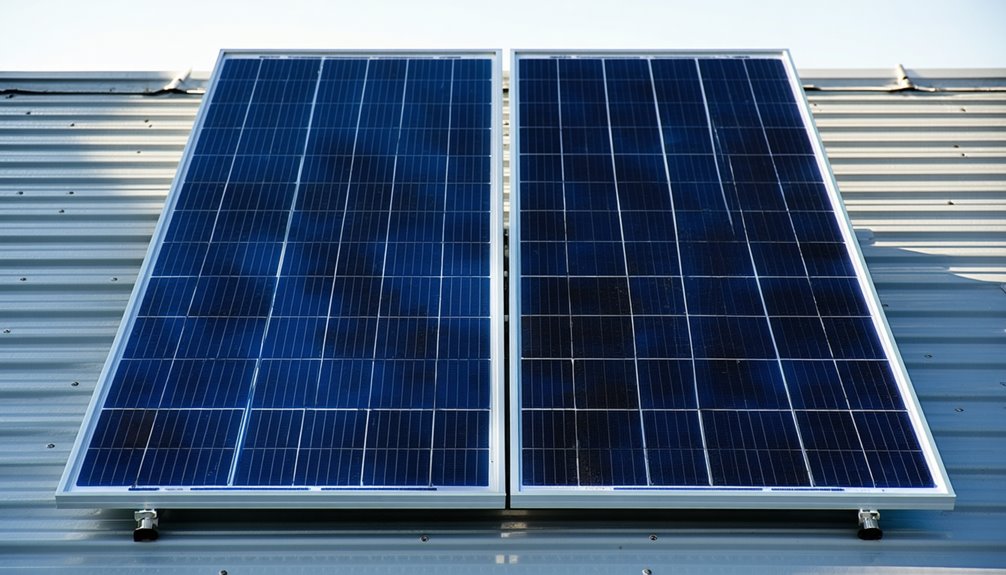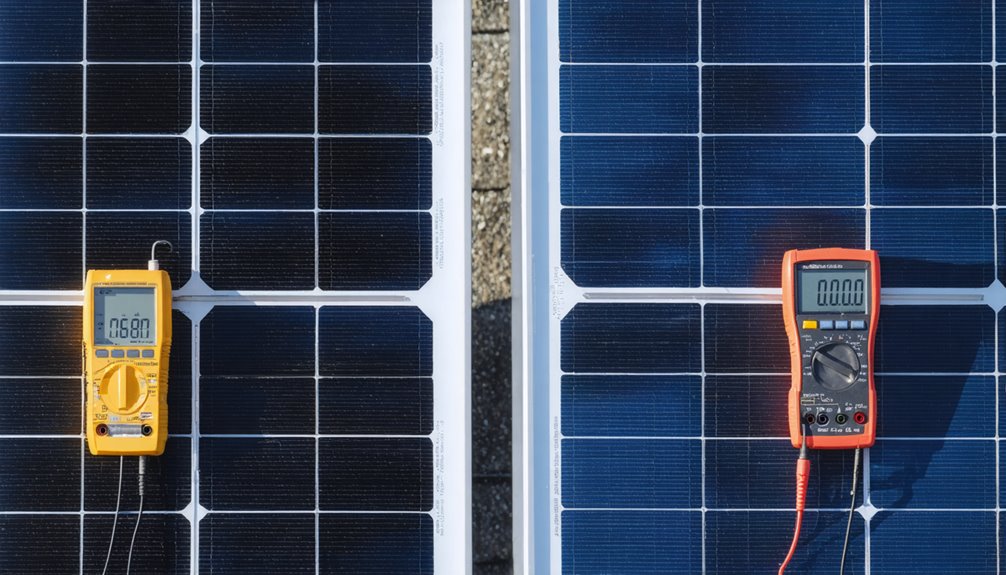You face a key decision when choosing solar panels: monocrystalline or polycrystalline? You need to weigh their efficiencies to maximize your energy output and savings. Start by understanding how these panels convert sunlight differently, but that’s just the beginning. Consider how they perform in real-world scenarios and hold up over time—three essential tips await to guide your choice.
Key Takeaways
- Monocrystalline panels achieve 15-23% efficiency, outperforming polycrystalline’s 13-20% range.
- Monocrystalline panels generate more electricity per square foot due to higher sunlight conversion.
- In partial shading, monocrystalline panels maintain better efficiency than polycrystalline ones.
- Monocrystalline panels perform superiorly in high temperatures, minimizing efficiency loss.
- For limited space, monocrystalline panels require fewer units to match polycrystalline output.
Assessing Efficiency Ratings and Output

When you’re evaluating solar panels, how do monocrystalline and polycrystalline types stack up in efficiency ratings and output?
You’ll notice monocrystalline panels typically hit 15% to 23% efficiency, outpacing polycrystalline ones at 13% to 20%. This means you convert more sunlight into electricity with monocrystalline options, enhancing overall output.
You get more power per square foot from monocrystalline panels, so you need fewer units for the same energy production, saving space on your roof or land.
Their superior temperature coefficient guarantees you lose less efficiency in heat, unlike polycrystalline models that drop output more markedly.
Over time, monocrystalline panels deliver better longevity and total energy production, often offsetting higher costs with savings.
Consult a reliable solar panel supplier to compare specs and verify these advantages for your setup.
Evaluating Performance in Varied Conditions
As you explore solar panel options, you’ll find monocrystalline types excel in varied conditions compared to polycrystalline ones. You get higher efficiency from monocrystalline panels at 15-23%, versus polycrystalline’s 13-20%, so they produce more power in limited space.
Consider partial shading: monocrystalline panels maintain better output, while polycrystalline ones suffer more. In high temperatures, monocrystalline options show less efficiency loss, ideal for warm areas, as polycrystalline panels’ higher temperature coefficients reduce productivity quickly. You’ll also notice monocrystalline panels thrive in low-light scenarios, like cloudy days, generating more electricity than polycrystalline counterparts.
| Condition | Performance Comparison |
|---|---|
| Partial Shading | Monocrystalline outperforms polycrystalline |
| High Temperatures | Monocrystalline has lower efficiency drop |
| Low-Light | Monocrystalline generates more electricity |
Analyzing Long-Term Value and Durability
Beyond initial performance, you’ll discover that monocrystalline panels deliver superior long-term value through their 15-23% efficiency, enabling more energy production in less space than polycrystalline panels’ 13-20% range.
You’ll appreciate monocrystalline panels’ longer lifespan, backed by a typical 25-year warranty, compared to polycrystalline ones’ shorter durability and reduced performance in high temperatures.
These panels excel in low-light and warm climates thanks to a lower temperature coefficient, minimizing efficiency losses where polycrystalline options falter.
In terms of value, you’ll save more on electricity costs over time with monocrystalline panels, despite their higher upfront price, as they generate equivalent power with fewer units than cost-effective but less efficient polycrystalline panels.
Their energy payback time spans 1-4 years, quicker than polycrystalline’s 2-3 years, underscoring enhanced longevity and output.
Opting for Tier-1 solar panels ensures top-tier manufacturing quality and financial stability from leading global producers, enhancing the overall durability and performance of your solar installation.
Conclusion
You’ve compared efficiency ratings, where monocrystalline panels shine at 15-23% for space-saving installs. You’ve seen they outperform polycrystalline in shading and heat, maintaining steady output. Finally, you’ve weighed long-term value—opt for tier-1 makers to secure warranties and durability. Ultimately, if you prioritize top efficiency and reliability, choose monocrystalline; they’re your best bet for maximizing solar investment over time.


